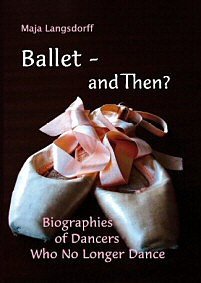Ballet - and Then?
Biographies of Dancers Who No Longer Dance
![]() What becomes of ballet dancers when they finally leave the stage, when their last
curtain falls?
What becomes of ballet dancers when they finally leave the stage, when their last
curtain falls?
Dancers live their lives in the limelight. They give a lot, if not everything, in the performances. In ballet, profession and calling are united: passion and suffering are often close to each other.
For most dancers, their time is up at thirty, thirty-five. They disappear from view. One doesn't hear anything about them anymore; as if they were swallowed up by the earth.

This book investigates their fates. Maja Langsdorff interviewed 27 former
dancers and recorded their life stories from their first ballet steps to their lives
after dance. At the time of their interviews they were between 21 and 62 years old,
their careers had ended from three months to 34 years ago. These short biographies
show what formed them, what moved them, what influenced them. And the portraits
leave no doubt, that dancers are special people; even if they no longer dance.
For one cannot become a dancer, one is born a dancer.
 In conversations with people who have made ballet their profession, one repeatedly hears “Ballet is like a drug.” Only those who have an intense passion for dancing can become professional dancers. For hardly any other profession demands so much sacrifice, so much energy, so much discipline, so much self control. What fascinates dancers about their work is the possibility of using their instrument, the body, to communicate through the music on stage and to express emotions through movement. Dancing is their life, their calling - not their job. Most of them can not imagine a life without dancing. And the more exclusively they live in the close, protected world of ballet, the more difficult it is for them to leave this world and find a new orientation when their career in dance ends. In the present times, this usually occurs in their late twenties or early thirties. In this book, lives and fates are documented, showing what helps in mastering the transition to a new life after dance: a good social network of family, friends, and acquaintances, but also interests and fascination with things aside from the ballet studio and the stage. Between the lines, one can sense how important it is to think about the "after" already "before." Unfortunately, many dancers just suppress such thoughts as long as they are dancing. |
To read: |
Preface by Fritz Hoever, Noverre Society, Stuttgart |
Photos |
There is a virtual photograph album with many ballet photos of the former dancers who are presented in this book. |
Press coverage: |
Statements from the most beautiful review of this book |
Ballet - and then?
is published 2006 as a "Book on Demand". It has 271 pages and costs 19.80 Euros.
Attention - There are different ways to order this book:
-
The easiest: Please order the book via e-mail directly from me. Your Advantage: We share the postage, I will pay half of it.
- If you speak German:
Please order from a German (!) language internet bookseller like www.amazon.de. Disadvantage: You probably must pay all of the postage yourself. 
-
If you know a dedicated bookseller in your town: Please ask him, to order the book from me. Disadvantage: It will need some time until the book arrives at your address.
-
In Germany the bool is also available in your bookstore, ISBN: 3-8334-4419-3